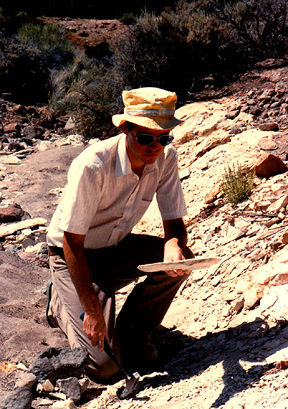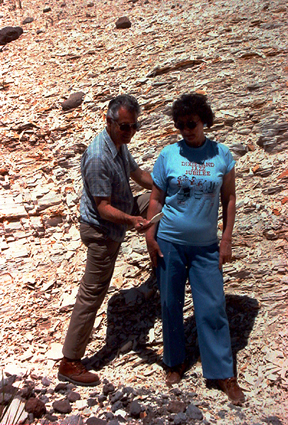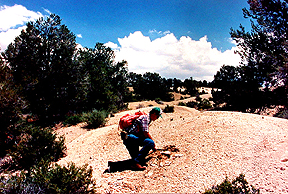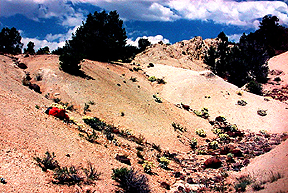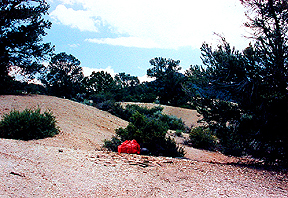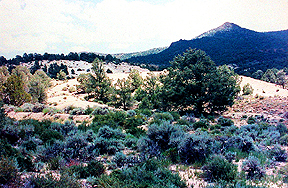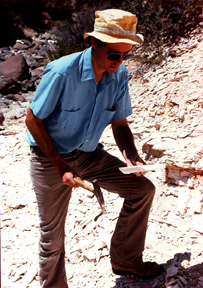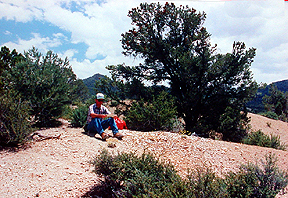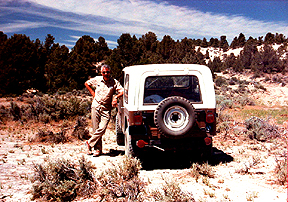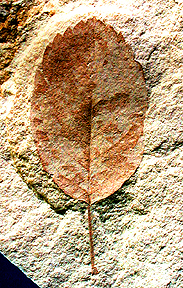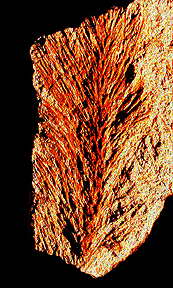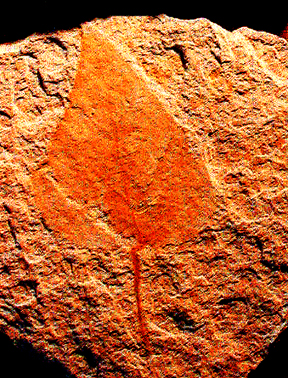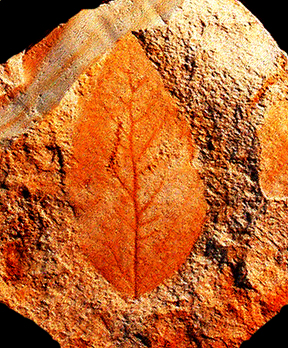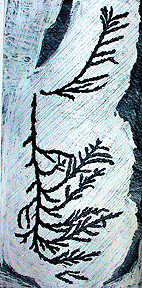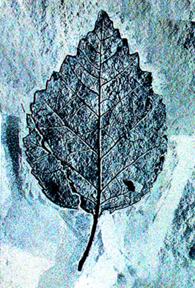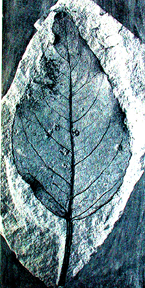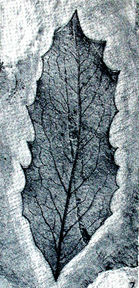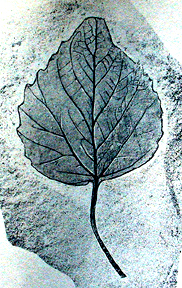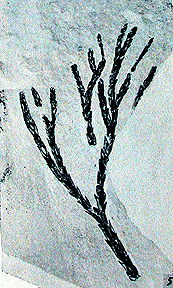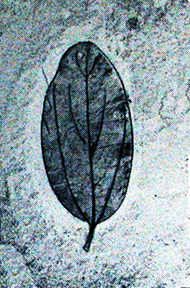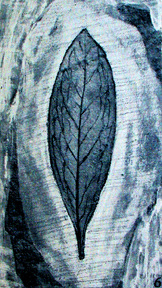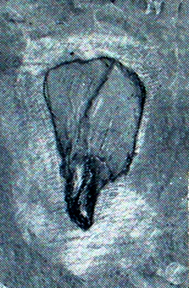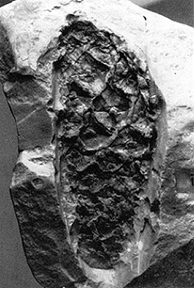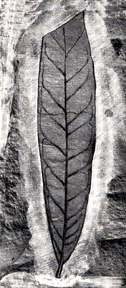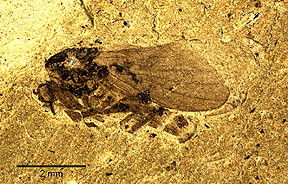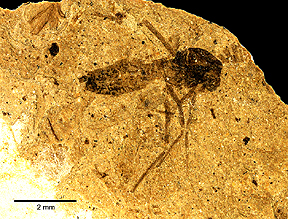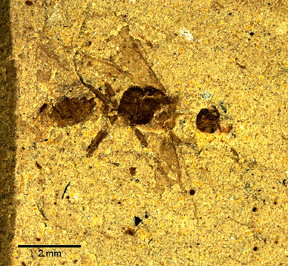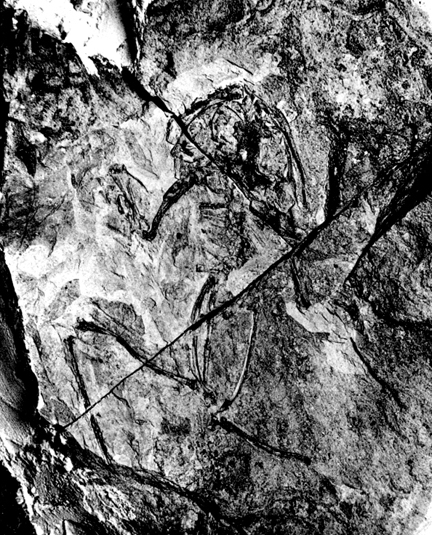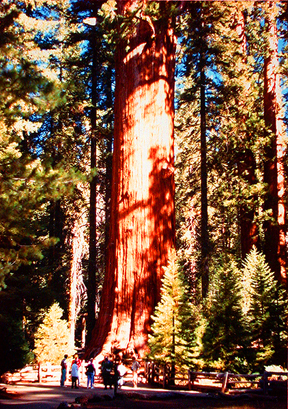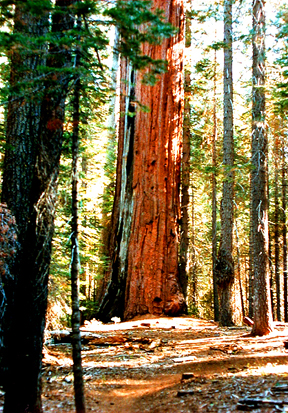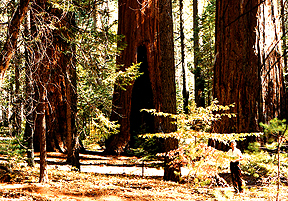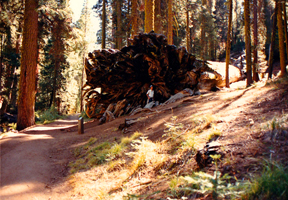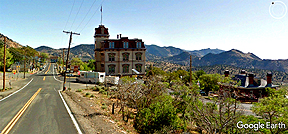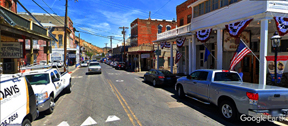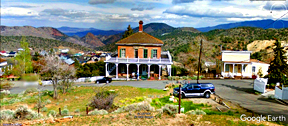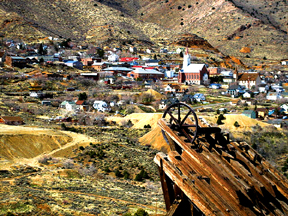|
When visiting Virginia City, western Nevada--the "Queen
of the Comstock"--take a special look around you at the
glorious Basin and Range scenery. It seems to sweep forever to
the east, beyond the horizon, in the heart of a great pinyon
pine-juniper woodland. The dominant shrub here is Basin sage,
with such regular subordinate associates as rabbitbrush, desert
peach, bitterbrush, and hairy horsebrush.
Now try to imagine what this land would have looked like
some 12 to 13 million years ago: The pinyon pine-juniper-sagebrush
botanic component is gone, no mountains, only hilly topography.
In place of thirsty dry washes, many crystalline lakes and sluggish
streams lie scattered eastward in the distance. To the immediate
west, the central to southern sector of the ancestral Sierra
Nevada is but a relatively low ridge approximately 3,000 feet
high and gives no apparent indication that its summits will continue
to rise, on average, many thousands of feet with the passing
of geologic time (the northern Sierra Nevada has of course stood
at roughly its present-day height since around 50 to 40 million
years ago). All around you, enveloping you, is a dense mixed
conifer forest of Douglas-fir, western white pine, ponderosa
pine, white fir, and magnificent giant sequoia. The overall scene,
in fact, is strikingly similar to the modern-day moist western
slopes of the Sierra Nevada in the vicinity of Calaveras Big
Trees State Park, some 23 miles northeast of Angels Camp, California--an
area that supports an inspiring giant sequoia forest community.
If such a vastly different character of the land seems
downright shocking---patently unbelievable in the main--the verifiable
proof its existence in the geologic past can be examined only
a moderate distance from the exciting Old West atmosphere of
Virginia City in western Nevada, where the internationally renowned
Comstock Lode yielded incalculable fortunes in silver and gold,
mainly from 1859 to the 1880s (when miners discovered at least
six individual, major bonanza bodies), with sporadic rich mineralization
encountered underground through the 1920s. Within a reasonable
driving distance of the famed silver mining camp lies a regional
badlands district where paleontologically productive exposures
of sedimentary rock yield the remains of numerous species of
fossil plants, insects, and even frogs--all dating from the late
middle Miocene, some 12.7 million years old.
This Virginia City-vicinity fossil site is an especially
rich one. In addition to the remains of insects, occasional frog
skeletons, and prolific microscopic diatoms, some 30 additional
species of macrofossil plants have also been identified from
the Virginia City/Comstock Lode area, including giant sequoia
and such dicotyledonous deciduous varieties as willow, birch,
alder and cottonwood, for example. Most of the fossil beds occur
in an often economically lucrative sedimentary material called
diatomite, a rock type composed almost entirely of diatoms, a
microscopic photosynthesizing single-celled algae that periodically
proliferated in ancestral west to central Nevada during middle
to late Miocene times, contributing myriads of their intricately
designed frustules to the accumulating geologic record. Indeed,
in the early 1900s, a commercial mining operation extracted high
grade diatomite from the vicinity of the fossil locality near
Virginia City, and shipped the processed product to New York
for use in the manufacture of a silver polish; and that leads
to the rather curious consideration that perhaps numerous individuals,
in possession of silver ornaments and utensils created from Comtock
Lode mineral extraction, might have polished their valuable metallic
objects with a product originally mined near Virginia City, as
well.
In addition to its value as an abrasive in polishes, diatomite
also finds use in several other commercial applications, including:
filters (in swimming pools, for exzample; also helps clarify
beer and wine); insulation material; as a whitener in paints;
toothpaste; as an absorbent for pet litter and industrial spills;
a silica additive to cement and numerous other compounds; and
a well-known natural insecticide (AKA, Diatomaceous Earth).
Geologist Vincent P. Gianella discovered the Virginia City-vicinity
fossil flora in 1935 during his detailed investigation of the
Comstock Lode in the neighboring Silver City region (a small
community situated approximately four miles south of Virginia
City). For a preliminary estimate of its geologic age, Gianella
turned his collection over to then noted paleobotanist Ralph
Chaney, who determined that the ancient botanic specimens were
most likely of early Pliocene age--a rather raw initial relative
geologic age evaluation that eventually proved inaccurate, but
it was a close paleobotanical call due to a few exotic old-world
deciduous plant species in the Comstock Lode-area flora. More
recent, definitive, radiometric age-dating techniques (radioactive
isotope analyses) on volcanic constituents within the local stratigraphic
section constrain the flora to around 12.7 million years old--or
late middle Miocene in geologic age.
For a more detailed analysis of the fossil flora, Chaney
gave the specimens to a colleague, Mary S. Leitch, who concluded
rather incisively that in order to accomplish the task much more
fossil material needed to be collected; unable to undertake the
necessary collecting expedition, Chaney and Leitch eventually
directed 29 year-old paleobotanist Daniel I. Axelrod to head
out into the field. In 1939, Axelrod spent several days gathering
additional fossil plants at the Comstock Lode/Virginia City locality.
Axelrod's larger fossil sampling so altered the overall
paleobotanical aspect of the collection originally studied that
a whole new approach to its scientific interpretation was now
in order. When Dr. Leitch informed Dr. Chaney that she could
not complete the project due to a conflict in professional priorities,
Axelrod happily took over the study, and over the next numerous
years, interspersed among other scientific research projects,
cumulatively amassed decades in assiduous elucubrations before
eventually publishing a superior paleobotanical monograph on
the Virginia City-vicinity fossil plant locality.
In preparation for his technical paleobotanical treatise,
Axelrod employed especially efficient excavating expertise in
the field to secure some 3,639 fossil plant specimens from the
Comstock Lode/Virginia City flora. He then determined through
methodical statistical analyses that the most common plants encountered
were leaves belonging to (1) Populus eotremuloides, the
Miocene analog of the living Black cottonwood (Populus trichocarpa)--followed
by, in decreasing order of relative abundance: (2) Betula
thor (leaves)--Paper birch, Betula papyrifera; (3)
Salix knowltoni (leaves), Lemmon's willow--Salix lemmonii;
(4) Populus washoensis (leaves), Bigtooth aspen--Populus
grandidentata; (5) Chamaecyparis linguaefolia
(leafy twigs and cones)--Lawson cypress, Chamaecyparis
lawsoniana; (6) Amelanchier alvordensis (leaves)--western
serviceberry, Amelanchier alnifolia; (7) Sequoiadendron
chaneyi (leafy twigs)--Giant sequoia, Sequoiadendron giganteum;
(8) Pinus wheeleri (fascicles and seeds)--Western white
pine Pinus monticola; (9) Abies concoloroides (cone
scales, (needles, seeds and leafy twigs)--white fir, Abies
concolor; (10) Populus pliotremuloides (leaves)--quaking
aspen, Populus tremuloides; (11) Salix owyheeana
(leaves)--coastal willow, Salix hookeriana; (12) Ceanothus
chaneyi (leaves)--Deer brush, Ceanothus integerrimus;
(13) Ceanothus leitchii (leaves)--Tobacco brush, Ceanothus
velutinus; (14) Rhododendron gianellana (leaves)--Western
azalea, Rhododendron occidentale; (15) Ribes stanfordianum
(leaves)--Flowering currant, Ribes sanguineum; (16) Pseudotsuga
sonomensis (leafy twigs, needles and seeds)--Douglas fir,
Pseudotsuga menziesii; (17) Pinus florissanti (cones
and needles)--Ponderosa pine, Pinus ponderosa; (18) Alnus
smithiana (cones)--Mountain alder, Alnus tenufolia;
(19) Castanopsis sonomensis (leaves)--Golden chinquapin,
Castanopsis chrysophylla; (20) Salix laevigatoides
(leaves)--Red willow, Salix laevigata; (21) Carya bendirei
(leaves)--Shagbark hickory, Carya ovata; (22) Quercus
simulata (leaves)--Chinese evergreen oak, Quercus myrsinaefolia;
(23) Mahonia reticulata (leaves)--Cascades oregon grape,
Mahonia nervosa; (24) Holodiscus idahoensis (leaves)--oceanspray,
Holodiscus microphyllus; (25) Prunus moragensis
(leaves)--Bitter cherry, Prunus emarginata; (26) Rhamnus
precalifornica (leaves)--California coffeeberry, Rhamnus
californica; (27) Arbutus matthesii (leaves)--Pacific
madrone, Arbutus menziesii; (28) Cupressus sp.
(leafy twigs)--a second species of cypress; (29) Tusga mertensiana
(seeds)--mountain hemlock; and (30) Pinus balfouroides
(cones)--Foxtail pine, Pinus balfouriana.
The fossil plant, insect, and amphibian (AKA, frog) material
is found exclusively in the sedimentary strata of a geologic
rock deposit called the Coal Valley Formation, dated at late
middle Miocene on the geologic time scale, approximately 12.7
million years old. Axelrod, for example, collected all of his
paleobotanic specimens from Member 3 of the Coal Valley Formation,
some 330 feet of pure white to creamy white well bedded diatomite,
often laminated, with occasional layers of yellow to brown andestic
tuffs and breccias roughly six inches to four feet thick.
Once at the specific site within a reasonable driving distance
of Virginia City and the fabulous Comstock Lode, hike into the
hills, looking especially for the brilliant white stratified
rocks--the diatomites (composed of diatoms, a microscopic photosynthesizing
single-celled algae) and associated fine-grained siliceous shales
which regionally underlie the diatom-rich deposits.
Axelrod's original primary fossil plant locality occurs
in a prominent exposure of diatomite roughly 15 feet thick and
about 30 feet long--obviously not an overly extensive area of
fossiliferous sediments, yet infrequent to moderately common
remains of deciduous and evergreen leaves occur here, in addition
to gymnospermous conifer seeds, leafy twigs, needles, fascicles,
cones, and cone scales. Use a geology pick/rock hammer to whack
out--read: carefully remove--the potential leaf-yielding rocks.
Should no evidence of a fossil appear on the exposed surface,
gently rap the diatomites along their bedding planes with the
blunt end of that same standard geology hammer. This procedure
will provide a greater opportunity to locate something extraordinary;
and please note, by way of a recommendation based on personal
experience--disabuse oneself entirely of utilizing one of those
wide blade roofer-type hammers, typically advocated by any number
of paleobonists for all plant-bearing sedimentary rocks. Maybe
such a roofer's "weapon" works well with classically
soft fissile shales, but the implement lacks punch, heft, the
necessary compact mass to efficiently cleave diatomites with
a single sure strike, a method that improves exponentially the
probability of discovering excellent paleontobotanical specimens.
Sometimes the fossil leaves remain difficult to spot due
to the sun's glare on the bleached bone-white diatomite, so try
getting into the shade of a nearby juniper or pinyon pine for
a more comfortable examination of the specimens. The 12.7 million
year-old leaf impressions typically appear in shades of reddish
orange to pale brown. And while deciduous and evergreen leaves
might at first blush appear most conspicuously represented, watch
carefully for conifer seeds, needles, fascicles, leafy twigs,
cones and cone scales--other botanic specimens commonly observed
here.
Approximately two-tenths of a mile northeast of the main
fossil locality first investigated by Daniel I. Axelrod lies
an abandoned open pit diatomite mine. Excellent representative
samples of high grade, quality diatomite can be collected here.
The most common diatom specimens from the Virginia City-vicinity
locality consist of Actincyclus cedrus and Melosira
granulata; under powers of moderate magnification (through
the implementation of microscopy), the diatom species fascinatingly
resemble miniature discs and boxcars linked together in short
chains, respectively. Paleoecologically speaking, a prevalence
of Actinocyclus cedrus and Melosira granulata diatoms
from the late middle Miocene Coal Valley Formation here signifies
that the lacustrine hydrologic system within which they propagated
probably displayed the following characteristics: moderate eutrophy;
a relatively shallow depth; warm monomictic, with regularly cyclic
circulatory mixing during winter; slight alkalinity, with a pH
level that would have registered close to 8.0; a high silica
content; and winter temperatures that never dropped below 39.2
degrees Fahrenheit.
Geochemical conditions required to stimulate a proliferation
of diatoms necessary to produce economically valuable deposits
of diatomite include: significant concentrations of silica, usually
supplied by volcanic activity; a pH that generally ranges from
6 to 8; high potassium and magnesium content, in relative relatonship
to low ratios of sodium and calcium; loads of the element boron;
and high proportions of phosphate and nitrate, generally provided
by upwelling waters in the lacustrine system.
While at the diatomite mine, examine the strata exposed
there for additional fossil leaves, needles, seeds and twigs--plus,
rare excellently preserved frog skeletons. Although not as plentiful
here, the macro-paleobotanical remains are sometimes present
within several layers of the less-pure, lower-grade diatomites,
the sediments with an off-white to brownish tone. The specific
species of fossil frog found in the late middle Miocene Coal
Valley Formation is called Rana johnsoni, an amphibian
that shows morphological relationships to two modern frogs. One
is Rana pipiens, the Northern leopard frog, now native
to parts of Canada southward through Kentucky and westward to
New Mexico (southernmost occurrence is in Panama, Central America,
though this is possibly an undescribed species); it prefers grasslands,
lakeshores, and marshes. The other resemblance is to the California
Red-legged frog Rana draytoni (historically endemic to
California's western Sierra Nevada foothills and coastal areas,
southward to the northern Baja peninsula, though for all intents
and purposes it's been extirpated from Los Angeles south to the
Baja border); in optimal natural habitat, the California Red-legged
frog likes ponds, streams, marshes, and springs, preferably with
deep pools that contain abundant overhanging willows and a fringe
of cattails.
Of course, it is well to remember that one must not collect
vertebrate fossils on public lands without first securing a special
use permit from the BLM (Bureau of Land Management), a permit
issued solely to individuals with a minimum B.S. degree from
an accredited university who either represent an officially recognized
museum, or seek to undertake scientific research projects that
can be fully verified as authentic by the petitioned authorities.
Another fossil type represented in the local late middle
Miocene Coal Valley Formation near Virginia City, Nevada, is
the arthropod--specifically, insects. They occur in detrital,
non-diatomaceous strata slightly older than the fossil plants,
but they're still in the neighborhood of approximately 12.7 million
years old. The matrix upon which they're preserved is quite reminiscent
of the classic paper shale deposits at world-famous Fossil Valley,
Great Basin Desert, Nevada (now a federally protected region,
completely off limits to unauthorized collectors). Here, though,
the brownish to tan shale beds that exhibit cleavable planes
of deposition no thicker than a proverbial sheet of paper are
nowhere near as extensively exposed as those featured at Fossil
Valley, and the insect preservations, while sometimes superbly
striking, remain far less commonly encountered, as well. Unfortunate,
that--most obviously--but due to the wholly natural vagaries
of variable fossil abundance in the geologic record, that's exactly
what one expects to experience in the field from time to time.
Paleoentomologic specimens thus far identified from the Comstock
Lode/Virginia City fossil district disclose dominantly diminutive
dipteran varieties--that is to say, a paleo-fauna comprised of
flies, gnats and midges, mainly, with a few hymenoptera also
present. Examples of paleobotanical preservations also occur
in the insect-bearing shales--on occasion, for example, one comes
across excellently carbonized remains of winged conifer seeds
and needles.
Based on the geological and paleobotanical evidence, the
present-day Comestock Lode/Virginia City-area paleontologic locality
indeed appeared dramatically different some 12.7 million years
ago. For example, the diatomites within which the fossil leaves
occur were laid down in a small lake basin at an altitude probably
no higher than 2,500 feet (though regional summits would have
ranged higher, of course), near the western terminus of the so-called
Miocene-age Nevadaplano that gradually increased in elevation
eastward toward the Rocky Mountains. By about 17 million years
ago, extensional tectonic forces had already begun to pry apart
portions of the nascent Great Basin, creating an emergent landscape
that adumbrated modern Nevada geography; based on geophysical
studies in Nevada's Pine Nut Range, westernmost ancestral Nevada
(including the Virginia City area), still part of the once vast
Nevadaplano, began to develop Great Basin-style geography through
extensional strains at roughly 6.8 million years ago. Bordering
the lake was a dominantly deciduous woodland consisting of Black
cottonwood, Paper birch, Bigtooth aspen, and three kinds of willows
(Lemmon's willow, Red willow, and coastal willow). A mixed conifer/Big
tree forest reached the shoreline along well-drained gravelly
stream banks that penetrated the riparian association. In addition
to Lawson cypress and giant sequoia, the primary forest species
present, there were also numerous examples of Douglas-fir, western
western white pine, ponderosa pine, white fir, mountain hemlock,
Foxtail pine, a second species of cypress, Golden chinquapin,
Shagbark hickory, Pacific madrone, and Chinese evergreen oak.
Included in the forest community were such understory shrubs
as bitter cherry, serviceberry, Deer brush, Flowering currant,
Western azalea, Cascades oregon grape, oceanspray, and Mountain
alder. Modern-day botanic associations that most closely resemble
the plant types preserved in the late middle Miocene Coal Valley
Formation near Virginia City can be explored in such California
areas as: Calaveras Big Trees State Park; Giant Forest in Sequoia
National Park; General Grant Grove, Kings Canyon National Park;
Sequoia Lake in Fresno County; and the south fork of the Sacramento
River, southwest of Mount Shasta.
Not only did the landscape support a greater variety of
vegetation than the present-day Great Basin terrain, but the
climate of those ancient late middle Miocene times was also corresondingly
more temperate. Today, rainfall in the region is about 15 inches
yearly; yet, the known requirements of living members of the
fossil flora show that at least 20 inches more rain fell approximately
12 to 13 million years ago, or roughly 35 inches annually. The
Miocene rains were distributed as both winter and summer showers--in
other words, pretty much year-round--whereas today's Mediterranean-style
meteorological patterns, in areas of California's western Sierra
Nevada foothills that support giant sequoias and other plants
either identical or at least very similar to those observed in
the fossil flora, produce effective rain and snow only from winter
through spring; summers there typically provide but a paucity
of precipitation, creating a somewhat less mesic environment
than what existed in the vicinity of Virginia City during late
middle Miocene times. That difference in seasonal rainfall eliminated
from modern Sierran sequoia habitats all botanic species in the
fossil flora that require regular, substantial summer showers:
paper birch; Chinese evergreen oak; Lawson Cypress; a second
species of cypress (Cupressus sp.); mountain hemlock;
and Shagbark hickory. At the fossil site today, virtually every
ounce of effective precipitation arrives as snow during the winter.
Probably the Miocene frost-free season was as long as seven months--while
today it's closer to four. In general, it appears that late middle
Miocene winters were much warmer and summertimes cooler than
those observed during recent times.
Today, Virginia City lies on the western edge of the arid
Great Basin. As a physiographic province, this mountainous land
dominates all of Nevada, in addition to portions of eastern California,
southeastern Oregon, southern Idaho, and western Utah. It is
a region characterized by three archetypical botanic types--sagebrush,
juniper, and pinyon pine. Yet, the Comstock Lode-vicinity fossil
plants prove that 12.7 million years ago a diverse deciduous
and evergreen dicotyledon community mingled with a rich mixed
conifer forest amid a moist environment quite similar to a giant
sequoia/Big tree grove in present-day California.
At that distant Miocene time, the southern to central Sierra
Nevada district was but a relatively minor ridge, perhaps 3,000
feet high, and nourishing rainstorms from the Pacific had free
run across ancestral west-central Nevada. Vegetation was lush,
the climate temperate--a rain-saturated humid scene reminiscent
of today's western foothills of the Sierra Nevada and a tributary
of the Sacramento River near Mount Shasta.
Eventually, about three million years ago, the central
to southern Sierra began to rise in earnest, reaching skyward,
thrust upwards thousands of feet by potent tectonic forces, until
the now exposed western slopes captured most of the eastward-driven
precipitation. In ancient Nevada, the once extensive forests
of Big trees died back, shrinking, finding their final refuge
in isolated, environmentally favorable localities in the western
Sierran foothills. Aridity reigned. The numerous lakes and streams
dried up, vanished, leaving behind within secret sedimentary
layers their wonderful evidence of a prehistoric age, the fossil
plants, insects and frogs waiting in the rocks, waiting for us
to learn of what once existed in this part of western Nevada
so many millions of years ago.
|
